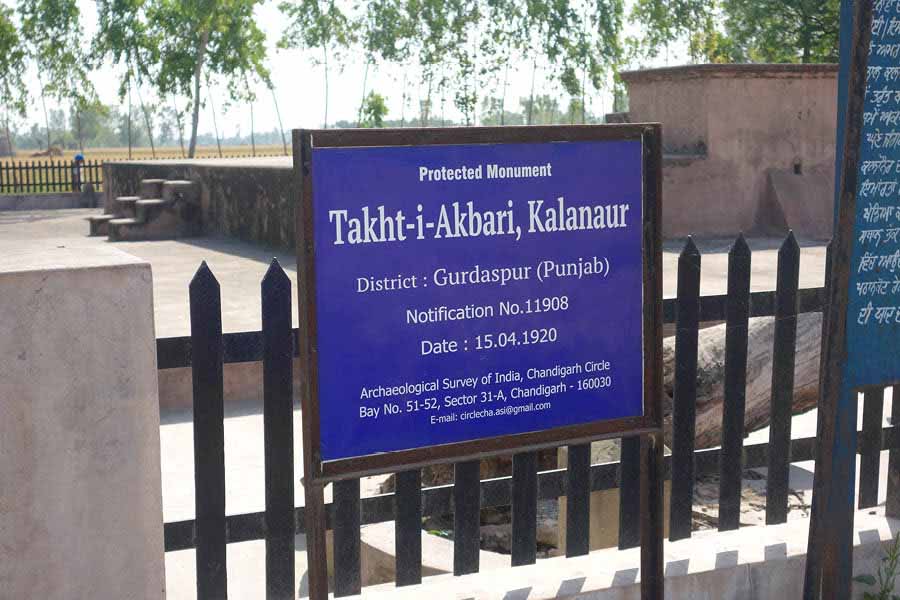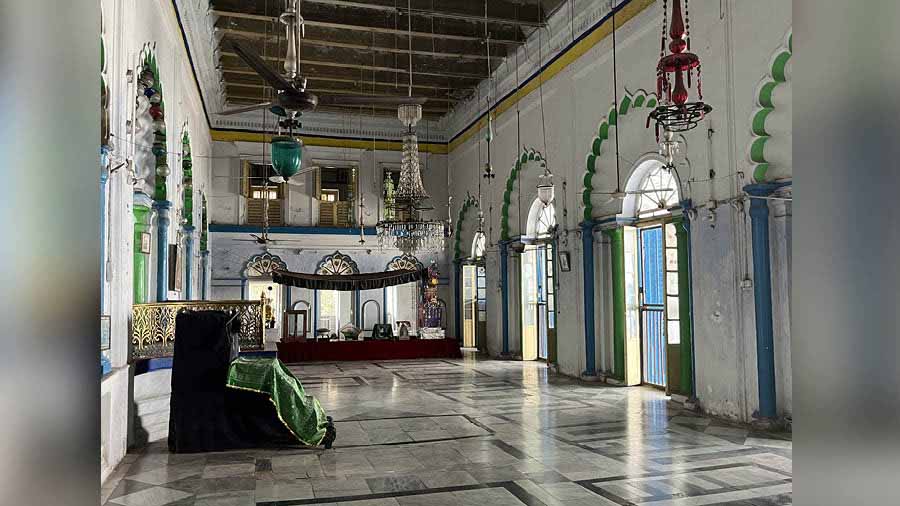Kalanaur is a small village in Punjab that few would have heard of it, let alone visited. Yet this village, an hour’s drive from Amritsar and close to the Pakistan border, has made an oversized contribution to Indian history. For it was here, on February 14, 1556, that a young and unruly boy-prince, the 14-year-old Jalaluddin Muhammad Akbar, was crowned the king of Hindustan.
Akbar padshah’s brick coronation platform, the Takht-i-Akbari, still stands among the swaying wheat fields of Kalanaur. It’s a mute reminder that this is where it all began for one of India’s most famous rulers. Not in the celebrated corridors of Delhi or Lahore or Agra – all of them cities associated with Akbar – but here, in the rural heart of Punjab.
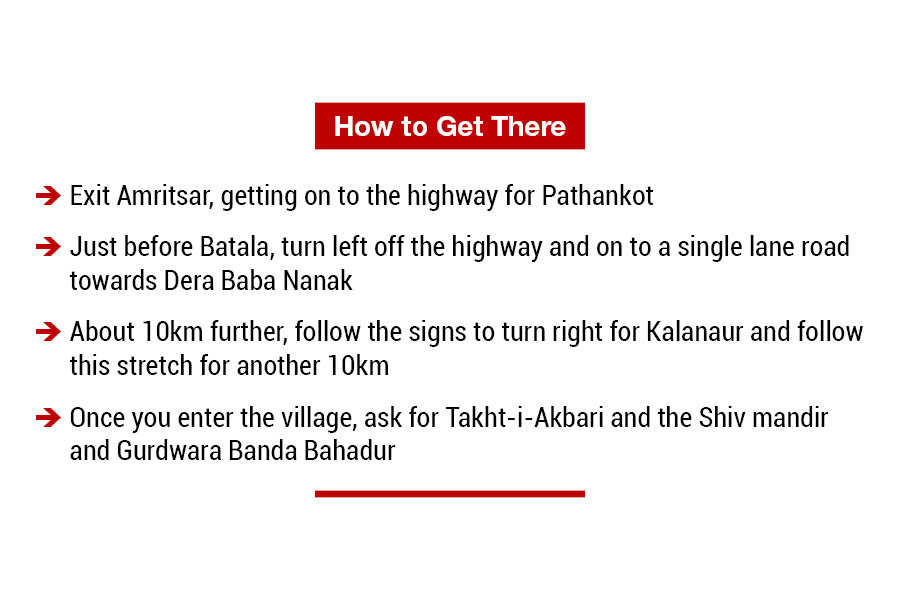
Waiting to get to Kalanaur
Kalanaur is difficult to go to when treated as a one-off. But I was visiting the Golden Temple at Amritsar and combined with that it made for a perfect itinerary. Being the history buff that I am, I could hardly wait to connect with one of the greatest kings my country has produced. What a bonus, and so close to Amritsar.
So, on a bright April morning with a slight winter nip in the air, my driver Simranjeet and I left Amritsar for Kalanaur, with Punjabi pop music blaring from the car radio. One of the pleasures of driving in Punjab is the soothing view of lush fields stretching to the horizon. It was spring, a few days before Baisakhi, and the wheat had turned a ripe golden yellow, ready for harvesting. As we drove, Simranjeet kept up a constant chatter.
“Sirji, did you know Baisakhi is celebrated even in Canada?”
“Sirji, farmers have now banned the lighting of fires at spring. Because their dry crops could get burnt.”
“Sirji, earlier we had eucalyptus trees lining these highways. Now it is poplar, much better for making plywood and matchsticks.”
Occasional brick kilns stood erect in the yellow-green fields, emitting lazy smoke-plumes into the pale blue sky. Simranjeet had views on this too….
“Sirji, these kilns get farmers an extra income. The kiln owners buy the clay for bricks from their fields.”
Just before reaching Batala, we came off the highway on to a narrow country road, passing small communities with typically rural scenes; gaily painted tractors, buffaloes tethered to the trees, stalls selling sugarcane juice, villagers at hand-pumps filling water in vessels. By mid-morning, after a pleasant hour’s drive from Amritsar, we entered Kalanaur.
The residents of Kalanaur clearly knew their legacy. I was quickly pointed the way to the Takht-i-Akbari and informed of the village’s other attractions; a famous Shiv Mandir, and the Gurdwara Banda Bahadur.
Hidden by the gently swaying wheat fields…the Takht-i-Akbari
We were guided off the main tar road, on to a kutcha track that wound its way through the fields. We passed the crumbling, haunting ruins of what was once the impressive Akbari masjid, its massive pillars and fine carvings a reminder of its past beauty. Besides it was a small shrine with an unknown grave covered with a green cloth, empty of worshippers. It was apparently once a part of the Akbari masjid, with the shrine was tended to by locals.
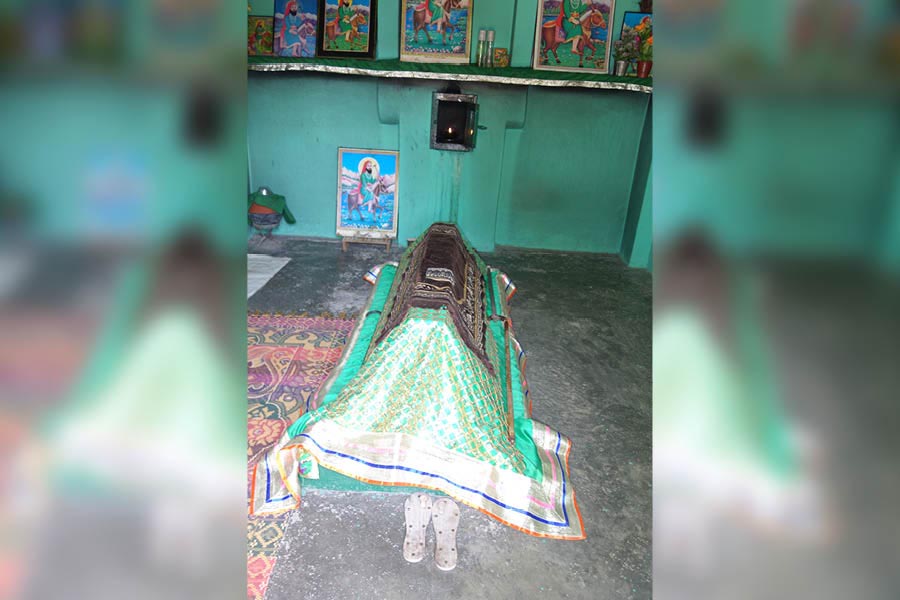
Next to the haunting pillars of the Akbari mosque was a one-grave shrine, maintained as a living legacy by the locals of Kalanaur
We continued to bounce down the mud track, asking people working in the fields for directions to the Takht-i-Akbari. Then suddenly in front of us, hidden by the gently swaying waist-high wheat fields, was a neatly fenced enclosure with a bright blue ASI sign, the Takht-i-Akbari.
I stepped out of the car to take in the scene. Birds twittering, fresh air, and the gurgling sound of clear water. Akbar’s coronation platform lay quietly in the middle of this pastoral setting. A small tabela (cowshed) stood on one side, with cud-chewing buffaloes looking listlessly on. A water pump gushed out sparkling, water into a narrow stream that disappeared towards the fields. There was an overwhelming silence and peace.
As I looked over the coronation platform and the tranquil fields, I tried imagining this site 500 years ago.
A coronation platform hastily built by Akbar’s mentor, Bairam Khan
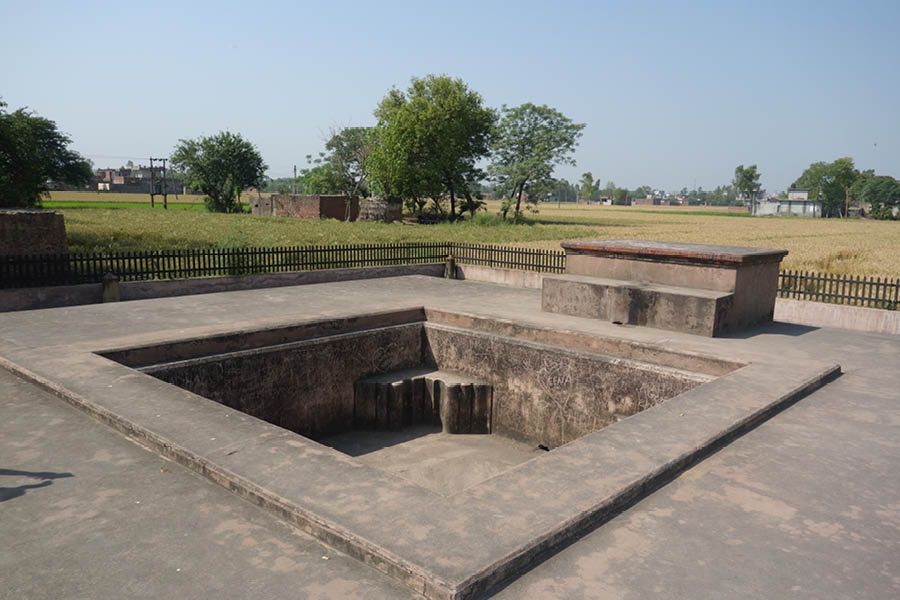
Akbar’s coronation platform, where the 14-year-old boy-king was crowned king of Hindustan
This brick platform was erected by Bairam Khan, young Akbar’s guardian and tutor, as soon as he heard about the death of Akbar’s father, Humayun. Emperor Humayun had died suddenly and unexpectedly, slipping on the stairs of his library in Delhi’s Purana Qila (Old Fort). At the time, the young prince, Akbar, and Bairam Khan were camped at Kalanaur, close to the Ravi river, with the Mughal army.
Bairam Khan decided on quick action. A masonry platform was built, with a brick throne on top of it. Humayun had died on January 26,1556. At midday on February 14, on a date and time considered astrologically auspicious, Akbar was crowned emperor of Hindustan. His ascension formalised right here on this coronation platform, without elaborate ceremony.
However, this was after all the Mughal empire. Whatever be the need for haste, some style and grace was mandatory. There is a water feature in the middle of the Takht-i-Akbari, a square water tank about five-feet deep with floral shaped carvings on the four corners. I climbed down into the water tank, thinking to myself, why the need for this, in the harsh winter cold of February in Punjab? But of course, to provide the impromptu stage some additional pageantry and flourish, a dignity fit for the coronation of a Mughal king!
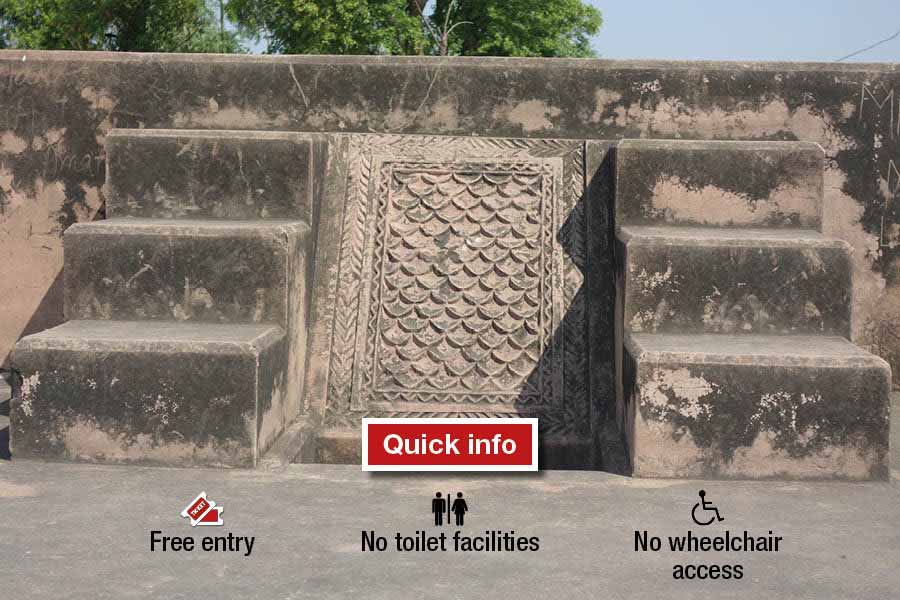
Carved masonry for the platform’s water feature: some style and grace to befit the occasion
Bairam Khan and Akbar: love, respect, intrigue and death
Who was Bairam Khan, the man who built this coronation platform and ensured the continuity of the Mughal lineage?
Born in Badakshan (now Afghanistan), Bairam Khan was a military commander who served three successive Mughal emperors — Babur, Humayun and Akbar — and was a steady hand on the shoulder for each.
The bond between Bairam Khan and the young Akbar was rooted in mentorship and loyalty. Bairam played a huge role in stabilising the empire and guiding Akbar’s success, especially in his teenage years. But Akbar was a wilful youth, and as he sought to assert his independence, their relationship gradually turned bittersweet.
When Akbar turned 18, he dismissed Bairam from the court. The seasoned general initially accepted his changed circumstances with dignity, but as often happens, other court members tried to rub in the humiliation and unexpectedly, the proud Bairam spun around in revolt. His revolt was short lived. When Bairam was captured and bought before Akbar, the young emperor treated his former guardian with the highest respect. In the words of the court historian Abul Fazl:
“..all the emirs and khans went out, by the emperor’s order, to meet him, and conducted him to the emperor with every mark and honor”.
Then, Akbar “with his sacred hand raised Bairam Khan’s head from the ground of humiliation and embraced him. He took the cloth from his neck and wiped from his face the tears of penitence and the dust of shame…. he enquired about his health and bade him sit on his right side, as had been the rule when Bairam Khan was prime minister”.
The rift between the two continued to weigh heavily on both. When Bairam Khan was killed – murdered at Patan in Gujarat by a gang of Afghans loyal to Hemu, whom Bairam had defeated and killed at the Panipat battle – Akbar rescued his former mentor’s family and took them under his wing. This included Bairam’s young four-year-old son Abdur Rahim, who would later scale the same heights as his father, becoming the highest noble in Akbar’s court as Abdur Rahim khan-i-khana.
A young prince; ‘not a boy who must be managed, but a Master would be obeyed’
So here I was at Kalanaur, standing on the coronation platform built by Bairam Khan for Akbar, at a moment in time pivotal to our country’s history.
When Akbar heard the news of his father’s death, Abul Fazl writes he wept “…as much for himself as for his lovable though eccentric father. The burden of the empire was on him suddenly, and he was not yet done with childhood”.[1] He was just 14 years old at the time.
I decided to sit on the brick throne as Akbar would have 5 centuries ago. To my side would have stood the loyal Bairam Khan. In front of me, the Mughal army. Neither would have realised that in this young prince, “they had not a boy who must be managed, but a master would be obeyed”.
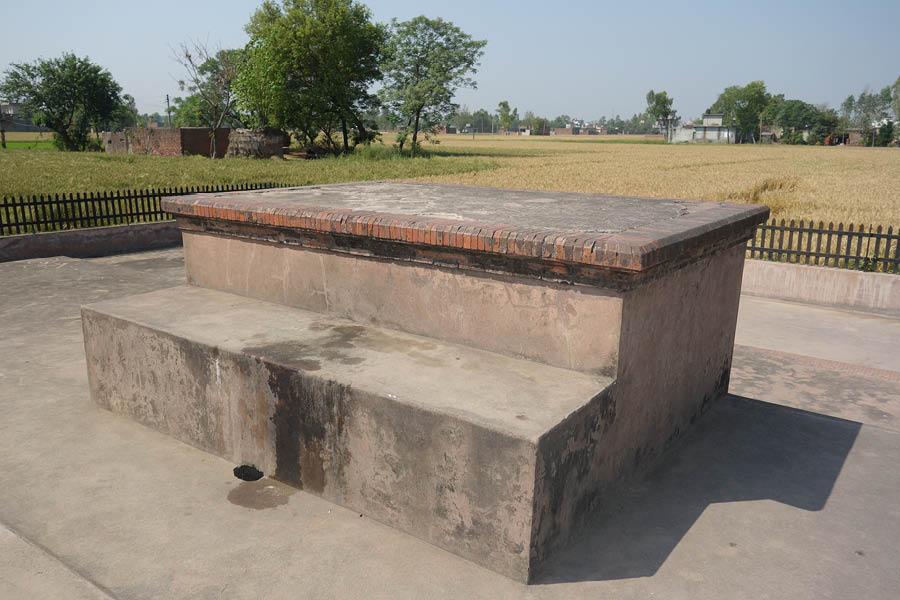
The brick throne where 14-year-old Akbar sat, to be crowned the next Mughal emperor
Taking in the remote isolation of the Takht-i-Akbari, with just the soft gurgle of flowing water and the undulating wheat fields for company, I felt an indescribable sadness and poignancy in the air. Where I was sitting, one of India’s greatest sons had begun his journey. An “illiterate and unruly youth of fourteen” who had ruled the country for 50 years, and in the words of the historian Abraham Eraly “…inaugurated the second golden age of India, after the decline of its classical civilisation a thousand years earlier”
This is where a golden-hued chapter in India’s history had started. Akbar went on to create a mighty Mughal empire, that was famous all over the world and synonymous with our country. And yet, the Takht-i-Akbari is quietly forgotten. Just a handful of history enthusiasts are interested enough to visit. There are no statues, no ceremony; no recognition for one of India’s best.
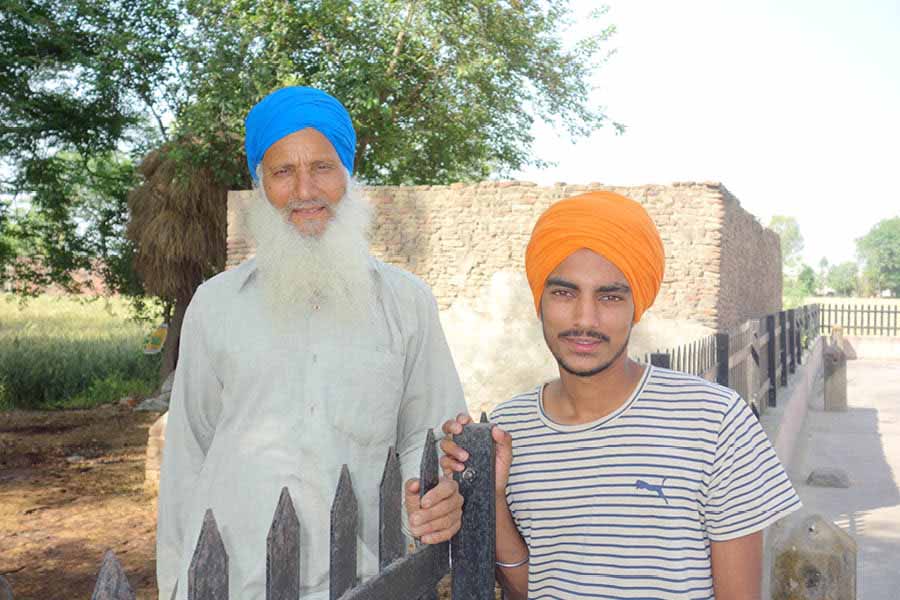
Harbhajan Singh and his son keep the Takht-i-Akbari spotless and clean
I was nudged out of my thoughts by the gentle Harbhajan Singh, who works on these fields and is paid a modest sum by the ASI for maintaining the Takht-i-Akbari. He had a red-coloured visitor’s register for me to sign. We chatted. He knew the value and significance of this location and did a fine job keeping it neat and well swept, with no litter, despite uncaring school kids attempting to carve names on the masonry. I complimented Harbhajan on his excellent work. By such slender threads does our heritage survive.
The sun was now hot in a cloudless sky. As I got back into Simranjeet’s car, he asked me how I liked the visit. What could I say? Simranjeet himself had started this journey with no clue about the historical gem in his own backyard. We were both overwhelmed. Just the thought that where we were standing, events that had shaped the history of India had been created, left us in awe.
Is there any other place in the world where one can sit on the coronation throne of the country’s most famous ruler? And be so close to historical legacy as to literally touch and feel it? I prayed that these remarkable monuments that adorn our country remain forever protected and cared for; both for our benefit and for future generations to visit and love the richness of their own heritage and history.
Sources:
1. Eraly, Abraham. The Last Spring. The Saga of the Great Mughals Part 1 (Published by Penguin Books India 2015)
2. Eraly, Abraham. The Last Spring. Life in India’s Last Golden Age. Part II (Published by Penguin Books India 2015)
3. Keay, John. India. A History : From the Earliest Civilizations to The Boom of The Twenty-First Century. (Published by Harper Press, London, 2010)
4. Ira Mukhoty. Akbar, the Great Mughal (Published by Aleph Book Co, 2020)
Annette Susannah Beveridge. Babur Nama translation Vol1 and Vol2. (Published by Oriental Books, New Delhi)
Adil Ahmad is a Kolkata-born discoverer deeply curious about the city’s heritage and history. He can be reached at hello@indiaheritage.in
